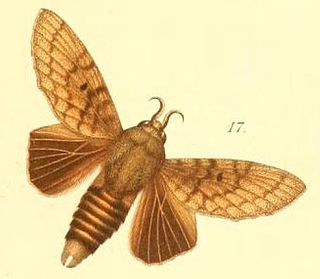Related Research Articles
Morini may refer to:

Prosoparia is a genus of moths of the family Erebidae. The genus was erected by Augustus Radcliffe Grote in 1883.
Stellidia is a genus of moths of the family Erebidae. The genus was erected by Achille Guenée in 1857.

Gastroplakaeis is a genus of moths in the family Lasiocampidae first described by Heinrich Benno Möschler in 1887.

Lophostola is a genus of moths in the family Geometridae described by Prout in 1912.
Tetracha annuligera is a species of tiger beetle in the subfamily Cicindelinae that was described by Hippolyte Lucas in 1857. The species can be found in Brazil, Bolivia, Argentina, and Peru.

Homelix is a genus of longhorn beetles of the subfamily Lamiinae, containing the following species:

Tenthredopsis is a genus of common sawflies belonging to the family Tenthredinidae subfamily Tenthrediniinae. These sawflies are present in most of Europe.

Homelix arcuata is a species of beetle in the family Cerambycidae. It was described by Chevrolat in 1855, originally under the genus Pachystola. It is known from Gabon, Cameroon, and Nigeria.

Homelix cribratipennis is a species of beetle in the family Cerambycidae. It was described by James Thomson in 1858. It is known from Tanzania, South Africa, Burundi, Cameroon, Rwanda, the Democratic Republic of the Congo, Gabon, the Ivory Coast, Angola, Malawi, Nigeria, the Republic of the Congo, Sierra Leone, Togo, the Central African Republic, Uganda, Ghana, and Zimbabwe.
Homelix cruciata is a species of beetle in the family Cerambycidae. It was described by Stephan von Breuning in 1937, originally misspelled as "Homelix cruciatus". It is known from Uganda.
Homelix liturata is a species of beetle in the family Cerambycidae. It was described by Quedenfeldt in 1882. It is known from Tanzania, Angola, the Republic of the Congo, the Democratic Republic of the Congo, and possibly from the Ivory Coast.
Homelix morini is a species of beetle in the family Cerambycidae. It was described by Pierre Téocchi in 1999. It is known from Cameroon, the Democratic Republic of the Congo, and the Central African Republic.
Homelix variegata is a species of beetle in the family Cerambycidae. It was described by Karl Jordan in 1894. It is known from the Republic of the Congo, the Democratic Republic of the Congo, and Gabon. It feeds on Coffea canephora.
Homelix albofasciata is a species of beetle in the family Cerambycidae. It was described by James Thomson in 1858, originally spelled as "Homelix albo-fasciata". It is known from Gabon.
Homelix decussata is a species of beetle in the family Cerambycidae. It was described by Chevrolat in 1856, originally under the genus Pachystola. It is known from Nigeria, the Ivory Coast, Cameroon, and the Republic of the Congo. It feeds on Coffea canephora.
Homelix klingi is a species of beetle in the family Cerambycidae. It was described by Kolbe in 1893. It is known from the Central African Republic, Sierra Leone, the Ivory Coast, Kenya, the Democratic Republic of the Congo, Mali, Tanzania, Cameroon, Togo, and Zambia.
Homelix vittata is a species of beetle in the family Cerambycidae. It was described by Per Olof Christopher Aurivillius in 1914, originally misspelled as "Homelix vittatus". It is known from Sierra Leone and the Ivory Coast.
References
- ↑ BioLib.cz - Homelix annuligera. Retrieved on 8 September 2014.